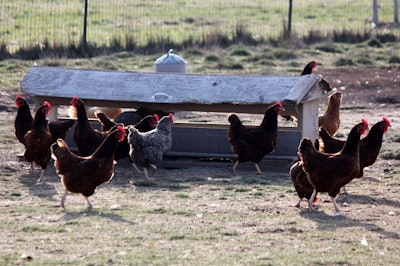
A new study out of Germany poses an intriguing question: Does pet food represent an “innovative distribution channel for animal welfare meat?” And answers it with a qualified yes, because pet owners seem concerned about how food production animals are cared for and more willing to pay a premium price for products using meat from animals raised to supposedly higher welfare standards.
First some caveats, the reasons why I say it’s a qualified yes. The study seems to have been conducted from the perspective of the human food world; it was published in the International Journal on Food System Dynamics and presented at a conference called System Dynamics and Innovation in Food Networks 2017. The main objective for the authors, Wiebke Pirsich and Ludwig Theuvsen of the Department of Agricultural Economics and Rural Development at Georg-August University in Germany, was to see if the pet food market is viable for achieving “added value for by-products that accrue in the production of animal welfare meat,” rather than addressing whether such by-products were suitable ingredients for pet food.
Also, the study included only German consumers. While Germany is the second largest pet food market in Western Europe, behind only the UK, its annual sales register just 3.16 billion euros (US$3.7 billion), according to 2015 data from Euromonitor and ZZF (the German pet industry association) cited in the study report. Updated data from Euromonitor put pet food sales growth in Germany at only 0.9 percent in 2016. Extrapolating consumer sentiments from a country that represents less than 5 percent of the global pet food market of US$75.25 warrants caution.
Intriguing results for other developed pet food markets?
Yet, the study’s results are intriguing enough to raise interest and further questions for pet food markets outside of Germany, especially developed and fast-developing ones. The clean label movement, trending in both human food and pet food in multiple countries globally, includes animal welfare-related claims among the many falling under its umbrella. Some pet food companies, such as Open Farm, have even built their business model on using ingredients with humane certification.
According to the study’s authors, Western European consumers are increasingly critical of traditional livestock farming and production processes; they cited a 2007 study showing that a “large number of EU citizens attached great importance to the protection and improvement of the welfare of farmed animals,” with 78 percent of Germany consumers agreeing that the welfare conditions of farm animals need to be improved.
This is not just a European phenomenon. In the US, a June 2017 study of consumers about their chicken consumption and purchasing habits showed three animal welfare-related issues – how chickens are bred to optimize meat produced, how chickens are housed and how chickens are raised – were chosen by at least 40 percent of the respondents as among their top concerns.
In Europe, that type of consumer sentiment has led to the development of a segment of the meat industry called “animal welfare meat: meat and meat products that originate from animals kept in production systems fulfilling higher animal welfare standards than required by law and labeled based on the guidelines of animal certification programs,” the study’s authors wrote.
While the meat industry believes these products have market potential, their costs have held them back to date. “Each slaughtered animal delivers a wide spectrum of very diverse meat and by-products, which all have to be marketed for different purposes,” the authors explained. “So far, it is mainly premium cuts that can be sold at higher prices, so they have to bear the entire additional costs of higher animal welfare standards.” Hence, the study’s investigation into whether some of the other cuts could be sold into the pet food production stream, particularly for premium pet food for which pet owners have shown they’re willing to pay a premium price.
Pet owners seem willing to pay more
The study found that among the German respondents, non-pet owners were about as likely as pet owners to consider certain animal welfare-related label claims on meat products mandatory. These included free-range production, improved housing conditions, antibiotic free and GMO free (in terms of the feed fed to the livestock). The percentage of respondents considering these claims mandatory ranged from 61 percent to 81 percent.
Yet there was some difference among pet owners and non-pet owners in terms of willingness to pay more for meat products labeled with animal welfare claims. For example, nearly 36 percent of pet owners said they would pay up to a 20 percent premium, versus just under 32 percent for non-pet owners; if the premium went up to 50 percent, nearly 14 percent of pet owners indicated a willingness to pay it, versus just 9 percent for non-pet owners. A few pet owners, about 5 percent, indicated a willingness to pay even up to a 100 percent premium.
The study authors cautioned that more specific research is needed to better determine the relationship between owning pets and willingness to pay for so-called animal welfare meat; and indeed they and other researchers at the University of Göttingen are working on that now.
By-products a deal breaker for pet food?
Depending on the findings of the additional research, pet food with animal-welfare claims for its meat ingredients could become popular in developed markets and, yes, likely fetch premium prices from pet owners willing to back their humane beliefs with their wallets.
Yet, in markets like the US, one key element of this concept and the research done to date could conceivably be a deal-breaker: the cuts of animal welfare meat being considered for pet food are mainly by-products, which, thanks to myths perpetuated online (aided and abetted by some pet food companies’ marketing tactics), are considered taboo by many pet owners. For example, when asked by Packaged Facts which types of ingredients they avoid when buying pet food, some US pet owners rank by-products at the top, with 25 percent of cat owners saying they avoid those ingredients.
Would the fact that the livestock animals were raised to higher animal welfare standards, with certification to prove it, offset the bias against by-products? That may be the most compelling question to investigate.



















